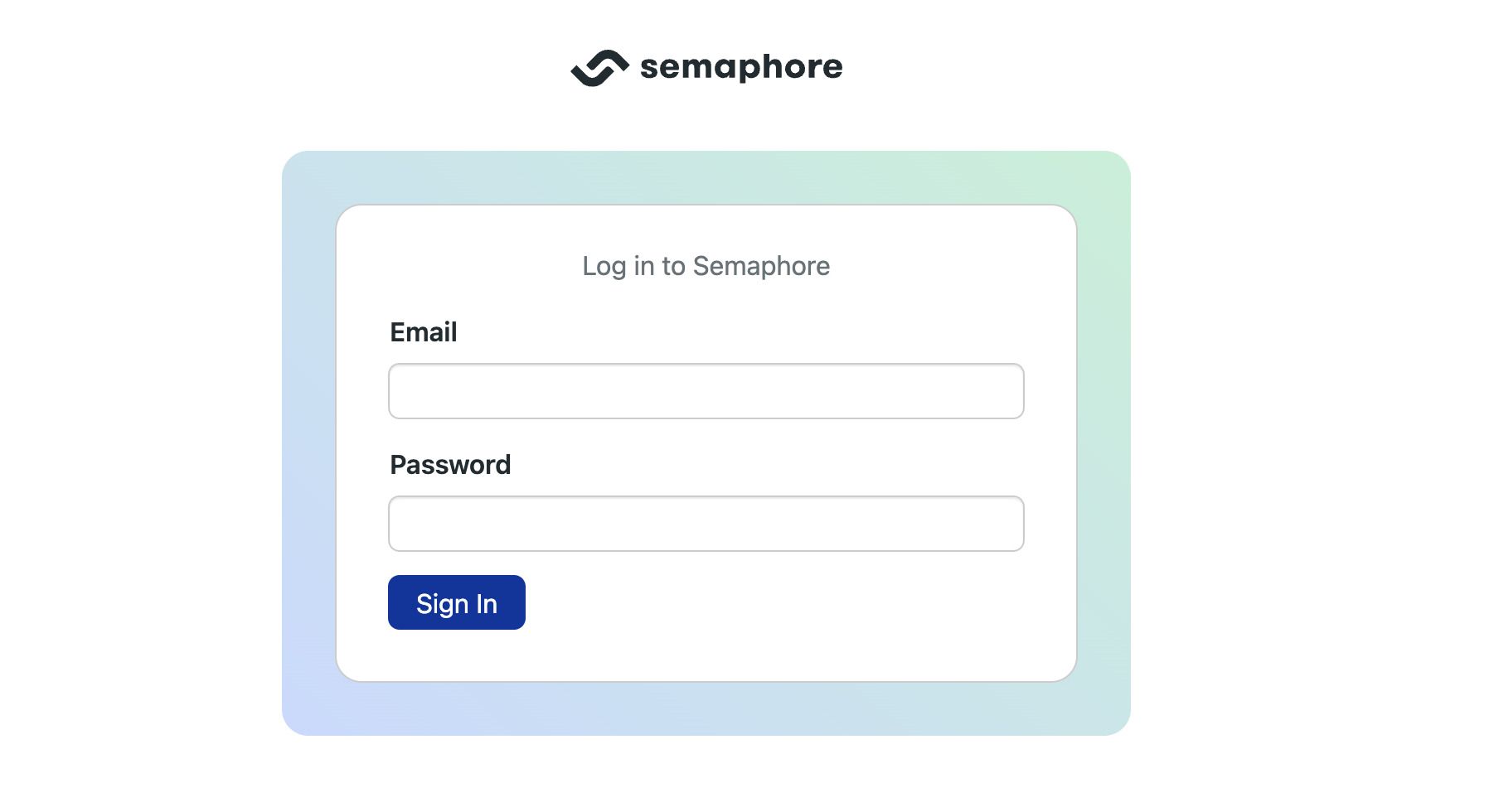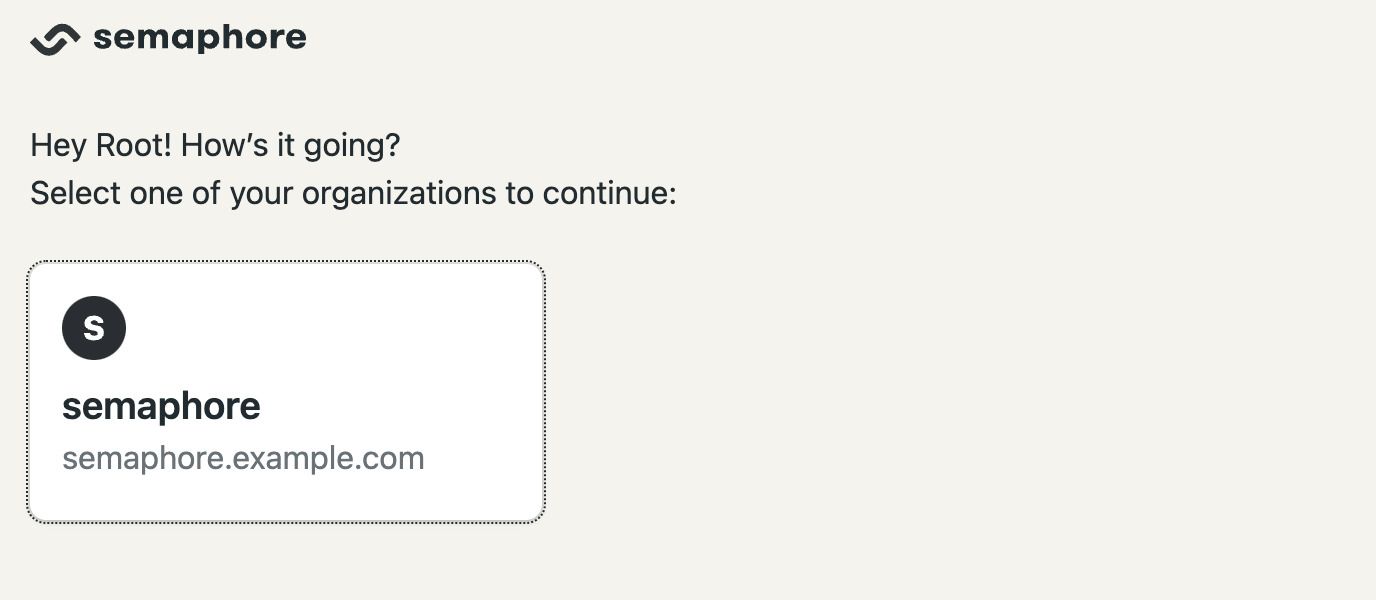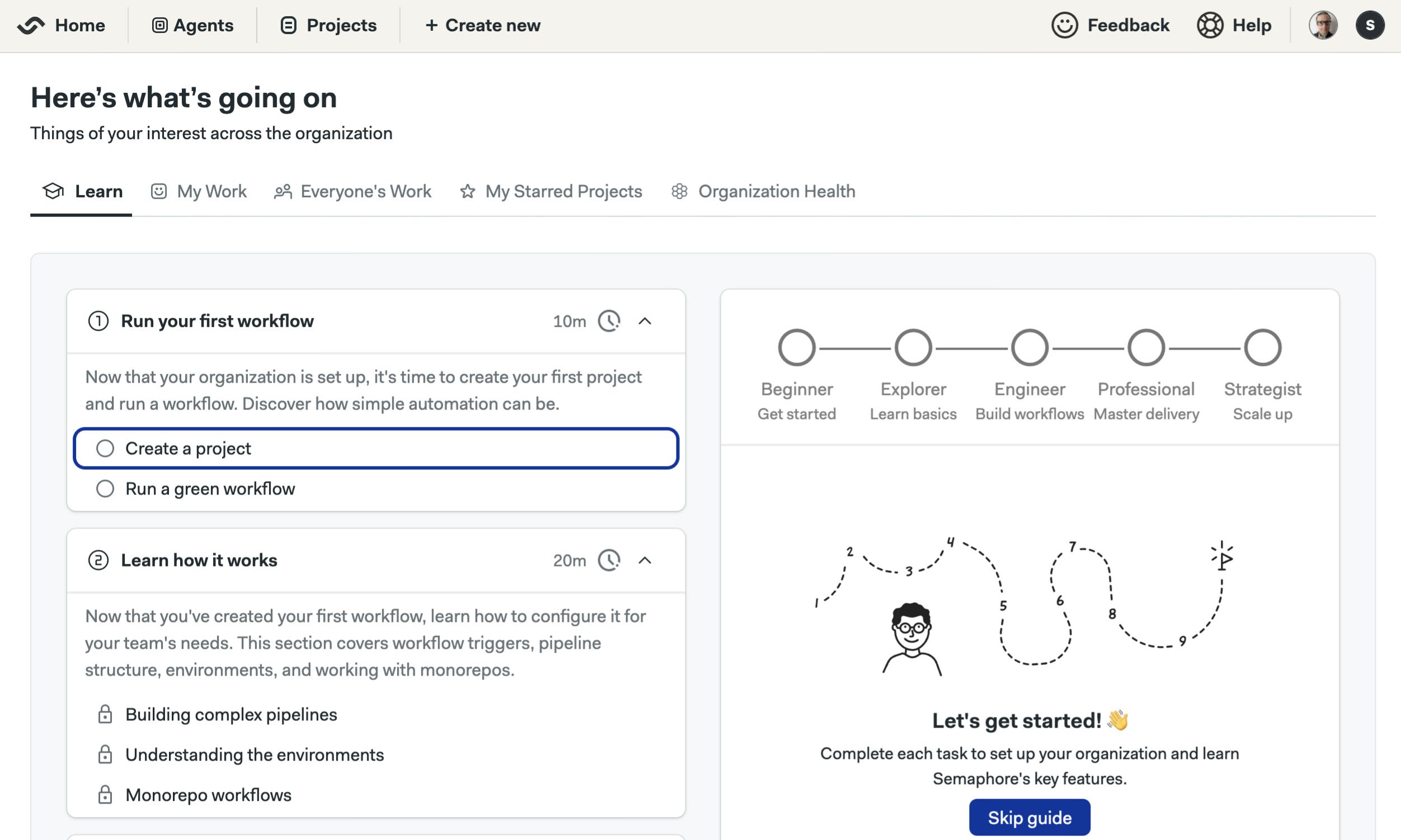Google Cloud Kubernetes (GKE)
This page explains how to create a Kubernetes cluster using Google Cloud Kubernetes Engine (GKE) and install Semaphore Community Edition.
Overview
If this is your first time using Semaphore we suggest trying out Semaphore Cloud to see if the platform fits your needs. You can create a free trial account without a credit card and use every feature.
The self-hosted installation is recommended for users and teams familiar with Semaphore.
There is a known issue that blocks Docker on macOS. If you have trouble running Helm and you're using macOS, check the following outstanding issue for a workaround.
Prerequisites
- A DNS domain
- A Google Cloud account
Step 1 - Install dependencies
Install the following tools before starting the installation:
- Google Cloud SDK: command line tools to create and manage your Google Cloud services
- Certbot: to create TLS certificates for your domain
- Helm: to install Semaphore
Step 2 - Set up Google project
It is recommended to create a Google Cloud Project for your Semaphore installation. Once you have created your project, take note of the Google Project ID.
Append the following lines to your configuration file. Adjust the values to match your Project ID and the zone where the Kubernetes cluster runs. We'll call this file google-config
export DOMAIN="<domain-to-install-semaphore>"
export GOOGLE_CLOUD_PROJECT_ID="<your-project-id>"
export GOOGLE_STATIC_IP_NAME="<id-for-semaphore-ip>"
export GOOGLE_CERTIFICATE_NAME="<your-tls-certificate-name>"
export GOOGLE_CLOUD_ZONE=<your-zone-id>
export GOOGLE_CLOUD_CLUSTER_NAME="<your-cluster-name>"
We highly recommend installing Semaphore on a subdomain, e.g. semaphore.example.com. Installing Semaphore on your main domain is discouraged as its operation might interfere with other services running on the same domain.
For example, if your domain is example.com, consider installing Semaphore on semaphore.example.com. See the example below.
export DOMAIN="semaphore.example.com"
export IP_ADDRESS=1.2.3.4
Once you have modified the configuration file, you should have something like the following example:
export DOMAIN="semaphore.example.com"
export GOOGLE_CLOUD_PROJECT_ID="my-semaphore-443021"
export GOOGLE_CERTIFICATE_NAME="my-semaphore-certificates"
export GOOGLE_STATIC_IP_NAME="my-semahore-ip"
export GOOGLE_CLOUD_ZONE=us-central1-a
export GOOGLE_CLOUD_CLUSTER_NAME="my-semaphore-gke"
Load your Google config file with the following command:
source google-config
Authenticate with your Google Cloud account before continuing. The command opens a browser to log in to your account.
gcloud auth login
Once logged in, activate to your Semaphore project on the terminal with the following commands:
gcloud config set project "${GOOGLE_CLOUD_PROJECT_ID}"
Step 3 - Reserve a public IP
Reserve a public IP address for the Kubernetes ingress with the following commands:
gcloud compute addresses create "${GOOGLE_STATIC_IP_NAME}" \
--project "${GOOGLE_CLOUD_PROJECT_ID}" \
--global
Run the following command to access your assigned IP address:
export IP_ADDRESS=$(gcloud compute addresses describe "${GOOGLE_STATIC_IP_NAME}" \
--project "${GOOGLE_CLOUD_PROJECT_ID}" \
--global \
--format='get(address)')
echo export IP_ADDRESS=$IP_ADDRESS >> google-config
Take note of the IP address as you'll need it later.
$ echo $IP_ADDRESS
34.25.122.100
Step 4 - Create TLS certificates
You may skip this section if you already have wildcard certificates, e.g. *.semaphore.example.com for the domain where you are installing Semaphore.
We can use certbot to create a free wildcard TLS certificate with the following command:
source google-config
mkdir -p certs
certbot certonly --manual --preferred-challenges=dns \
-d "*.${DOMAIN}" \
--register-unsafely-without-email \
--work-dir certs \
--config-dir certs \
--logs-dir certs
When you are prompted to create a DNS TXT record to verify domain ownership. For example:
Please deploy a DNS TXT record under the name:
_acme-challenge.semaphore.example.com.
with the following value:
EL545Zty7vUUvIHQRSkwxXTWsirldw91enasgB5uOHs
Create the DNS TXT record before continuing the certificate generation. Follow the instructions on the terminal.
You can verify the creation of the TXT record in the Google Dig Tool. Type the challenge DNS TXT record and check if its value corresponds to the correct value.
Once done, you should get a message like this:
Successfully received certificate.
Certificate is saved at: certs/live/semaphore.example.com/fullchain.pem
Key is saved at: certs/live/semaphore.example.com/privkey.pem
This certificate expires on 2025-02-27.
These files will be updated when the certificate renews.
Check the existence of the certificate files on the following paths. You will require both files during the Semaphore installation.
- Full chain certificate:
./certs/live/$DOMAIN/fullchain.pem - Private key certificate:
./certs/live/$DOMAIN/privkey.pem
You may delete the TXT record from your domain at this point. It's no longer needed.
Step 5 - Install TLS certificates
Install the TLS certificates created before using the following command:
gcloud compute ssl-certificates create "${GOOGLE_CERTIFICATE_NAME}" \
--certificate="certs/live/${DOMAIN}/fullchain.pem" \
--private-key="certs/live/${DOMAIN}/privkey.pem" \
--project="${GOOGLE_CLOUD_PROJECT_ID}"
Step 6 - Create DNS records
Configure your DNS by creating two A records that point to the reserved IP:
-
Go to your domain provider's DNS settings
-
Create root domain A record
- Type: A
- Name:
semaphore(e.g.semaphore.example.com) - Value: the public IP address of your Linux machine
-
Create a wildcard record
- Type: A
- Name:
*.semaphore(e.g.*.semaphore.example.com - Value: the public IP address of your Linux machine
-
Wait for DNS propagation (typically a few minutes)
You can verify the creation of the TXT record in the Online Dig Tool for:
semaphore.example.com*.semaphore.example.com
Step 7 - Create Kubernetes Cluster
In this section, we create a 1-node cluster with the smallest machine that can run Semaphore with default parameters.
First, install the GKE plugin for the Google Cloud SDK:
gcloud components install gke-gcloud-auth-plugin
Next, enable the Kubernetes API for your project:
gcloud services enable container.googleapis.com --project ${GOOGLE_CLOUD_PROJECT_ID}
Finally, create the cluster. You may adjust the commands if you want to create more nodes or use more powerful machines. The command might take several minutes to complete.
gcloud container clusters create "${GOOGLE_CLOUD_CLUSTER_NAME}" \
--project "${GOOGLE_CLOUD_PROJECT_ID}" \
--zone "${GOOGLE_CLOUD_ZONE}" \
--num-nodes 1 \
--machine-type e2-custom-8-16384 \
--network "default" \
--subnetwork "default" \
--enable-ip-alias \
--cluster-version latest \
--no-enable-master-authorized-networks
Once done, ensure you can access the cluster with:
kubectl get nodes
Step 8 - Install CRDs
Semaphore requires the [Emissary CRDs] to be installed on the cluster. Install the Custom Resource Definitions (CRDs) with the following commands:
kubectl apply -f https://app.getambassador.io/yaml/emissary/3.9.1/emissary-crds.yaml
kubectl wait --timeout=90s --for=condition=available deployment emissary-apiext -n emissary-system
Step 9 - Install Semaphore
Sanity check that the environment is ready for the installation. The commands should not fail and return valid values:
source google-config
echo "DOMAIN=${DOMAIN}"
echo "IP_ADDRESS=${IP_ADDRESS}"
echo "GOOGLE_CERTIFICATE_NAME=${GOOGLE_CERTIFICATE_NAME}"
echo "GOOGLE_STATIC_IP_NAME=${GOOGLE_STATIC_IP_NAME}"
ls certs/live/${DOMAIN}/privkey.pem certs/live/${DOMAIN}/fullchain.pem
Run the following to install Semaphore:
helm upgrade --install semaphore oci://ghcr.io/semaphoreio/semaphore \
--debug \
--version v1.3.0 \
--timeout 20m \
--set global.domain.ip=${IP_ADDRESS} \
--set global.domain.name="${DOMAIN}" \
--set ingress.staticIpName="${GOOGLE_STATIC_IP_NAME}" \
--set ingress.enabled=true \
--set ingress.ssl.enabled=true \
--set ingress.ssl.certName="${GOOGLE_CERTIFICATE_NAME}" \
--set ingress.ssl.type="google"
Once the installation is done, you the following command should appear in the terminal:
=============================================================================================
Congratulations, Semaphore has been installed successfully!
To start using the app, go to https://id.semaphore.example.com/login
You can fetch credentials for the login by running this command:
echo "Email: $(kubectl get secret semaphore-authentication -n default -o jsonpath='{.data.ROOT_USER_EMAIL}' | base64 -d)"; echo "Password: $(kubectl get secret semaphore-authentication -n default -o jsonpath='{.data.ROOT_USER_PASSWORD}' | base64 -d)"; echo "API Token: $(kubectl get secret semaphore-authentication -n default -o jsonpath='{.data.ROOT_USER_TOKEN}' | base64 -d)"
=============================================================================================
Execute the shown command to retrieve the login credentials.
$ echo "Email: $(kubectl get secret semaphore-authentication -n default -o jsonpath='{.data.ROOT_USER_EMAIL}' | base64 -d)"; echo "Password: $(kubectl get secret semaphore-authentication -n default -o jsonpath='{.data.ROOT_USER_PASSWORD}' | base64 -d)"; echo "API Token: $(kubectl get secret semaphore-authentication -n default -o jsonpath='{.data.ROOT_USER_TOKEN}' | base64 -d)"
Email: root@example.com
Password: AhGg_2v6uHuy7hqvNmeLw0O4RqI=
API Token: nQjnaPKQvW6TqXtpTNSx
Verify installation
You can check that for possible installation issues by following these steps:
-
Ensure all pods are running. All pods should be in
Runningstate withREADYstatus showing all containers ready (e.g.,2/2).kubectl get pods -
Verify ingress configuration. The ingress should show the IP address you configured and no error messages.
kubectl get ingress semaphore -
Verify SSL certificate. The certificate should be in
ACTIVEstate.gcloud compute ssl-certificates describe "${GOOGLE_CERTIFICATE_NAME}"
Step 10 - First login
On new installations, the system may take up to 30 minutes to finish all setup tasks. If you cannot login right away, wait a few minutes and try again.
Open a browser and navigate to the domain to id.<your-domain>/login. For example: id.semaphore.example.com/login
Fill in the username and password obtained at the end of step 9.

Once logged in, select the Semaphore organization to continue.

You should be greeted with the onboarding guide.

Post installation tasks
Once your have Semaphore up and running, check out the following pages to finish setting up:
- Connect with GitHub: connect your instance with GitHub to access your repositories
- Invite users: invite users to your instance so they can start working on projects
- Guided tour: complete the guided tour to get familiarized with Semaphore Community Edition
- Add self-hosted agents: add more machines to scale up the capacity of your CI/CD platform
How to Upgrade Semaphore
To upgrade Semaphore, follow these steps:
-
Connect to your Google project (see Step 2)
-
Check that you can access the Kubernetes cluster:
kubectl get nodes -
Load the configuration file and ensure the certificates are in the correct folder. See Step 4 if you need to recreate the certificates.
source google-config
echo "DOMAIN=${DOMAIN}"
echo "IP_ADDRESS=${IP_ADDRESS}"
echo "GOOGLE_CERTIFICATE_NAME=${GOOGLE_CERTIFICATE_NAME}"
echo "GOOGLE_STATIC_IP_NAME=${GOOGLE_STATIC_IP_NAME}"
ls certs/live/${DOMAIN}/privkey.pem certs/live/${DOMAIN}/fullchain.pem -
Check the expiration date of the certificate. If it has expired, regenerate the certificate before upgrading
openssl x509 -enddate -noout -in certs/live/${DOMAIN}/fullchain.pem -
Run the following command to upgrade to
v1.3.0helm upgrade --install semaphore oci://ghcr.io/semaphoreio/semaphore \
--debug \
--version v1.3.0 \
--timeout 20m \
--set global.domain.ip=${IP_ADDRESS} \
--set global.domain.name=${DOMAIN} \
--set ingress.enabled=true \
--set ingress.ssl.enabled=true \
--set ingress.className=traefik \
--set ingress.ssl.type=custom \
--set ingress.ssl.crt=$(cat certs/live/${DOMAIN}/fullchain.pem | base64 -w 0) \
--set ingress.ssl.key=$(cat certs/live/${DOMAIN}/privkey.pem | base64 -w 0)
How to Uninstall Semaphore from GKE
If you want to completely uninstall Semaphore, follow these steps.
If you uninstall Semaphore you will lose access to all your projects, workflows and logs. You cannot undo this action.
First, uninstall Semaphore with the following command:
export KUBECONFIG=/etc/rancher/k3s/k3s.yaml
helm uninstall semaphore
Delete the persistent volume claims:
kubectl delete pvc \
minio-artifacts-storage-minio-artifacts-0 \
minio-cache-storage-minio-cache-0 \
minio-logs-storage-minio-logs-0 \
postgres-storage-postgres-0 \
rabbitmq-storage-rabbitmq-0 \
redis-data-redis-0
Next, release the IP address and remove the TLS certificate:
source google-config
gcloud compute addresses delete "${GOOGLE_STATIC_IP_NAME}" --global
gcloud compute ssl-certificates delete "${GOOGLE_CERTIFICATE_NAME}"
Finally, if you are no longer using the Kubernetes cluster, you may delete it with the following command. This completely destroys the Kubernetes cluster with any other things you might be running there.
source google-config
gcloud container clusters delete --zone "${GOOGLE_CLOUD_ZONE}" "${GOOGLE_CLOUD_CLUSTER_NAME}"